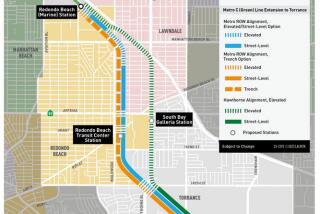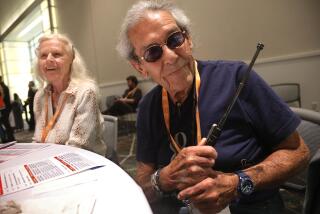Blue Line Horns In on Their Lives, Neighbors Say : Transit: Residents near tracks prepare a petition seeking to turn down the volume. But officials say the warnings are loud for safety reasons.
- Share via
When a Blue Line train barrels through the middle of the city, conversations pause, meetings stop, dogs howl, babies squall and just about everyone within earshot winces.
Every 10 or so minutes, for 20 hours a day, only one sound can be heard in the neighborhoods that line the tracks: the passenger train’s short, flat, very loud blare.
“With the windows closed, I can still hear that thing coming from three stops away,” said Compton City Clerk Charles Davis, whose office looks out over the railroad tracks.
Davis and longtime residents Emma and Guadalupe Reynoso, who live beside a railroad crossing, said they have been trying for about a year to persuade the Southern California Rapid Transit District to turn down the volume. This fall, the Reynosos gathered about 400 signatures of residents who say the horn is driving them crazy.
“No one around here needs an alarm clock anymore,” said one resident who asked not to be named. “The train wakes them up.”
The Reynosos and their neighbors complain that the horns start as early as 4 a.m. Guadalupe Reynoso’s irritation grew to such a point that he invited RTD officials to spend the night at his home. When no one took the offer, he took his tape player early one morning, pressed the “record” button and waited.
On Monday, Reynoso sat at the kitchen table, listening to the recording with a satisfied smile.
“Let’s call this train No. 1,” he narrates on tape. There is a brief silence. The muted sound of a horn wails in the distance, and then bells clang as track barriers go down. As the train approaches, the sound of five deafening horn blasts fills the Reynosos’ kitchen. Reynoso said that since RTD officials won’t come to him, he will send the tape to them.
After 10 years in their home on the corner of Willowbrook Avenue and Elm Street, he and his wife are thinking of moving. Other residents who live along the tracks complain that the horn keeps children up past their bedtimes, makes it almost impossible to watch television, startles toddlers out of morning naps and is just plain nerve-racking.
“We were happy about the Blue Line; we are still happy about the Blue Line,” Emma Reynoso said. “It’s the horn we don’t like.”
Compton residents are not the only people complaining. Blue Line conductors sound the horn before every intersection between Willow Street in North Long Beach and Washington Boulevard in Los Angeles. The RTD has received complaints from at least one resident in the unincorporated county area just north of Compton and from a resident who lives just south of Compton in North Long Beach.
Blue Line conductors don’t sound the horn in Long Beach and downtown Los Angeles because the trains stop at red lights and go at green lights with the rest of the traffic.
RTD officials say they know that the horn is a nuisance and are working on a way to warn drivers and pedestrians that the train is approaching without waking up the entire neighborhood.
Part of the problem is that between Long Beach and Los Angeles the Blue Line tracks parallel those of the Southern Pacific Railroad. State laws mandate that under those circumstances, the Blue Line must do as Southern Pacific does: sound a warning before every intersection, said Manuel Hernandez, RTD director of community relations. Southern Pacific trains, however, do not run through the city as often, and their horns are not as loud.
But safety is the main reason for the loud Blue Line horn, RTD officials said. The Blue Line zips through Compton between 45 and 55 m.p.h., and in the past more than one impatient driver has tried to beat the train through an intersection. Not everyone succeeded.
As a result of early accidents, the volume of the horn was upped from the state-mandated 85 decibels to 100 decibels--about four times louder, said Hernandez and officials from the Los Angeles County Transportation Commission. The difference in volume is comparable to the difference between the sound of average street traffic and that of a jackhammer, according to Bruel and Kjaer, an acoustic instrument manufacturer.
Stephanie Brady, director of communications for the transportation commission, said the two agencies are reviewing the noise standards of the Blue Line and will reach a decision on whether to change the horn’s noise level in the next two months.
Last month, in response to the complaints, a test horn set at 87 decibels was mounted on one of the trains. The new horn has satisfied many residents along the tracks, Emma Reynoso said.
“We’re not telling them to completely stop blowing the horn,” she said. “We just want them to have a little more concern for people in this area.”
More to Read
Sign up for Essential California
The most important California stories and recommendations in your inbox every morning.
You may occasionally receive promotional content from the Los Angeles Times.










